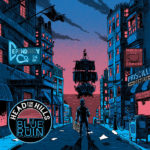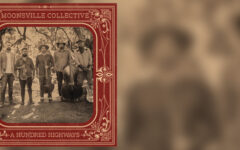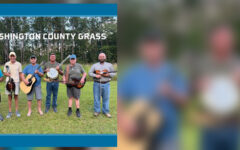
 There are certain instruments you can always expect to see listed in the credits of a bluegrass album. Banjo, guitar, fiddle, mandolin, and bass are all usuals, along with the occasional dobro, and even drums in more progressive groups. However, it’s not every day that you find a clarinet. Or a trumpet. Or a cello. However, on Blue Ruin, the latest album from Colorado-based group Head for the Hills, they meld with traditional bluegrass instruments to create an interesting, melodic mesh of jamgrass, indie rock, and several other styles of music.
There are certain instruments you can always expect to see listed in the credits of a bluegrass album. Banjo, guitar, fiddle, mandolin, and bass are all usuals, along with the occasional dobro, and even drums in more progressive groups. However, it’s not every day that you find a clarinet. Or a trumpet. Or a cello. However, on Blue Ruin, the latest album from Colorado-based group Head for the Hills, they meld with traditional bluegrass instruments to create an interesting, melodic mesh of jamgrass, indie rock, and several other styles of music.
It’s hard to assign a specific genre to this twelve-track album, although strains of bluegrass do run through the majority of the tracks. The opening cut, Take Me Back, is one of the most bluegrass-ish, both in sound (nice fiddle and mandolin) and lyrics (a man wishing for someone to “take me back where I belong”).
The album also closes on a grassy note, with the banjo-driven Light the Way (featuring guest Aaron Youngberg on the five-string).
Between those two songs, however, anything and everything goes – something not that surprising from a band that hails from the same state as the Telluride Bluegrass Festival. Never Does is perhaps the most unusual, and as last year’s IBMA Song of the Year would say, it’s certainly ‘a far cry from Lester and Earl.’
Many bluegrass bands probably haven’t heard of mid-2000s indie rock/punk band Panic! At the Disco, but this song could have definitely come from one of their albums. Dependency Co. samples from a few different genres even within the confines of one song, starting with almost-rapped vocals, followed by jazzy, swingy instrumentals (including a trumpet solo). Lover’s Scorn features pedal steel behind its tale of a man trying to free himself from a hateful woman who drinks all his liquor and makes his ears sore with her nagging.
The instrumental Breakfast Noir ventures back into familiar territory just a bit, with jazzy guitar and violin that could fit in with the more progressive side of bluegrass. Then, when you least expect it – clarinet. The title track also surprises listeners, this time with electric piano about halfway through. The album’s other instrumental, Priscilla the Chinchilla, more firmly steers toward bluegrass, and could really be considered a mandolin tune.
Honestly, the instrumentation on this album is well-done and the band members, as well as their guests, seem to be talented musicians. The varied instruments from the violin family particularly stand out. However, the mixture of musical styles leads to confusion and a cluttered sound. Most bluegrass instrumentation serves to support the singers by helping them tell their story. That’s not the case here, as the lyrics are often obscured by competing background sounds. At times, the instruments even seem to be fighting for the lead solo.
With that being said, Head for the Hills definitely has the potential to go over well at non-conventional festivals and venues. Band members Michael Chappell (mandolin), Adam Kinghorn (guitar and vocals), Joe Lessard (violin, octave violin, tenor banjo, and vocals), and Matt Loewen (bass, clarinet, and vocals) do many things well, especially their jazz-influenced solos. Jamgrass fans may want to take a listen.
For more information on Head for the Hills, visit their website at www.headforthehillsmusic.com. Audio samples can be found at Soundcloud.
Their new album can be purchased from Amazon and other online music retailers.







